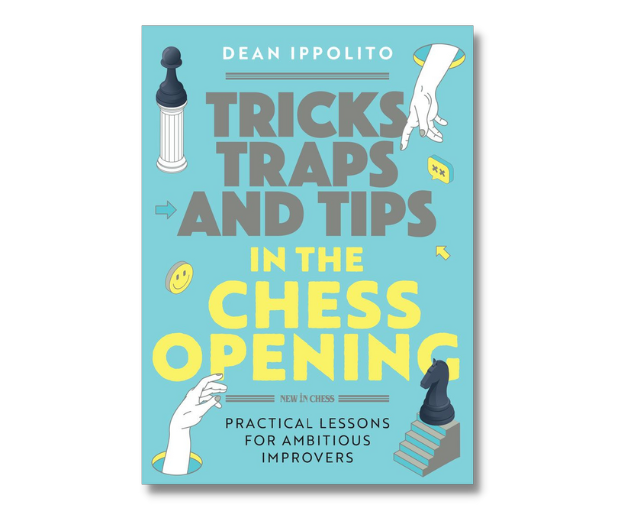Tricks, Traps, and Tips in the Chess Opening
Tricks, Traps, and Tips In The Chess Opening is geared toward players becoming familiar with the basic opening principles and common tricks. This book includes many of the most important instructive games used in my classes and is designed to ensure that players have a strong foundation from the beginning of the game.
Topics include:
- Early f-pawn moves,
- Early queen moves,
- Different attacks and sacrifices on weak spots.
Special attention is given to the most common and important traps such as the Center Fork Trick and the Fried Liver Attack.
Sample #1
Most of the common and dangerous traps (and mistakes) in the opening have something to do with the f-pawn. This is easy to understand, as that is the spot that is defended only by the king. Apart from simple mistakes and how to take advantage of them, the book is filled with practical examples from games that involve tactics that involve a sacrifice against the f-pawn.
The following example is taken directly from a class and involves a typical trick that all tournament players should be familiar with:
After 5…dxc3? White has a typical two-move double attack.
Question: Can you find it?
6.Bxf7+! Kxf7 7.Qd5+ Kf8
One of my students once won a game at nationals instantly after 7…Kg6? 8.Qf5#.
Back to the game: 8.Qxc5+ d6 9.Qxc3 Nf6
Trying to trade queens with 9…Qf6 was best, though of course, White doesn’t need to allow the exchange. Black instead threatens White’s pawn on e4.
10.0-0
Defending the e4-pawn with 10.Nbd2 just defending was safer with a nice edge.
Sample #2
One of the most common tricks in the opening is the Center Fork Trick. Due to how often it occurs at all levels, I have dedicated an entire chapter to the subject. First of all, here is the most common position where the trap occurs.
4.Bc4
Question: What is Black’s best move?
4…Nxe4!
Here is the Center Fork Trick! 4…Bc5 allows White to get away with an inaccurate move order which leads to a normal Four Knights position.
In chess as in life, small changes often greatly affect whether a decision is good or bad. One of the factors that I have always tried to highlight with students is that patterns are important. However, one cannot simply assume that because a pattern has worked in one position will mean that it will work in a nearly identical one.
Consider the two following similar positions:
White has the opportunity to use the Center Fork Trick in both positions with the move 5.Nxe5. In one position, it is the best move. In the other, it is a losing move, played many times even by strong Grandmasters. Can you find which is which?
Answer:
The first position is basically the same exact trick that Black used in the initial position. Here, the pawn being on a3 changes nothing. In the second though, the pawn on g3 changes everything.
5.Nxe5?? Nxe5 6.d4
It looks like all is in order except for one thing…
6…Bxd4!
Oops. White resigned because he realized he loses the queen if 7.Qxd4 Nf3+ with a double attack.
The right thought process is important, and in itself leads to a huge increase in playing strength, regardless of knowledge. Simply knowing that a difference may exist gives one the opportunity to discover it.
The book gives many similar examples, designed not only to increase knowledge but drive home the idea of the proper thought process.
Sample #3
A very detailed chapter covers the Fried Liver Attack, one that is essential for all tournament players. It is not just the idea of attacking the weak spot in this specific case, but the idea of attacking the weak spot in similar positions that should be understood. There are many typical mating attacks and patterns that appear over and over. Games from scholastic players all the way to world-class players highlight the themes.
Here is one of my favorite instructive games played by a student:
C. Wu – A. Shen, NJ K-3 Championship 2005
1.e4 e5 2.Nf3 Nc6 3.Bc4 Nf6 4.Ng5 d5 5.exd5 Nxd5 6.Nxf7 Kxf7 7.Qf3+ Ke6 8.Nc3 Ncb4
9.d4!?
White simply ignores Black’s threat while trying to open the black king.
Either 9.Bb3 (defending c2); or 9.0–0 followed by 10.d4 may be the absolute best ways to play, but anyone who finds themself in the same situation as Black surely will not know the best chance.
9…Nxc2+
9…exd4 loses to 10.Nxd5 Nxd5 11.Qe4+ and White will pick up the knight on the next move.
10.Kd1 Nxa1??
Black goes for a win of material, but this leads to a quick defeat.
10…Nxd4 was best but after 11.Bxd5+, Black’s king is still in trouble. After 11…Kd6 12.Qf7 threatens 13.Ne4#. Black can defend with (White could also play 12.Qg3 with a big mess. This doesn’t take anything away from this way of playing, as players who allow 6.Nxf7! are unlikely to defend perfectly. Additionally, 9.Bb3 or 9.0–0 are simply good for White.) 12…Qe7! and on 13.Ne4+ Kd7 14.Nc5+ Kd6 seems like a draw by perpetual check.
11.Bxd5+ Kd7
The only way to avoid mate was to sacrifice the queen, but that was hardly a good option.
Question: Find the mate in 3.
The answer is trivial if one remembers the rule that diagonal queen checks are often more dangerous than linear ones since they are less easily blocked.
12.Qf5+
Diagonal queen checks are often the best checks as they are more difficult to block. 12.Qf7+?? Qe7 and Black escapes.
12…Ke7
12…Kd6 13.Qxe5+ Kd7 14.Qe6#; 12…Ke8 13.Qf7#
13.Qf7+
13.Qxe5+ is also checkmate in 2: 13…Kd7 (13…Be6 14.Qxe6#) 14.Qe6#
13…Kd6 14.Ne4# 1–0
14.Nb5# was also checkmate. This was a very nice game for a 6–year-old to win the state championship for players up to 3rd grade (age 9).
The Wojo’s Weapons series is based on the very solid, practical opening repertoire used by the late Grandmaster Alexander Wojtkiewicz as White. This repertoire helped him to become one of the most successful open tournament players in the United States for years. The themes and ideas are easy to understand, and stand the test of time in an increasingly engine-reliant chess world. Very little will be changed by an upgraded engine, and the theory is based more on understanding rather than pure memorization. For that reason, club players through to Grandmasters have used the book for many years.
Dean Ippolito

Dean Ippolito has been regarded as one of the top scholastic chess coaches for well over two decades. He has personally worked with over 30,000 students and has taught many of the youngest national champions in the US. He is the author of six books, including the popular ‘Wojo’s Weapons’ Trilogy as well as his latest ‘Tricks Traps and Tips In The Chess Opening‘. As a player, Dean was a 10-time All-America Team member with 12 national championships. He was awarded the Frank J. Marshall Ambassador of Chess Award for his contributions to the chess world in 2011. Though his focus is mainly on coaching future champions, Dean remains active as a player and is continuing his pursuit of the Grandmaster title.
- Rock Solid Chess: Volume 2 - February 21, 2024
- Unsung Heroes of Chess - February 19, 2024
- Build Up Your Chess: The Fundamentals - February 7, 2024


